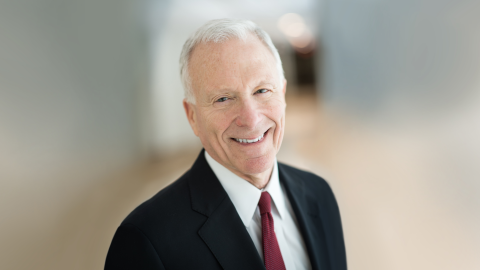Recently, a single man stepped into the mass demonstrations and counter-demonstrations that have roiled Turkey for weeks. The man stood still and silent, staring at an image on a wall. Soon scores of his countrymen, concerned about their freedoms, stood silently beside him, not just in Gezi Park, but in parks and squares across Turkey. It was a potent symbol in a war of symbols. In the Middle East, it may one day rank beside another standing man -- the man who stood before the tanks of Tiananmen. Time will tell if it will prove equally futile.
The protest in Istanbul's Gezi Park marks another round in a battle for Turkey's future. Among the silent stand those who seek a return to the moderate, secular path set by modern Turkey's founder, Kemal Ataturk. They face down not the tanks, but the bulldozers of Turkey's Prime Minister Recep Tayyip Erdogan. In the narrowest sense, Erdogan plans to bulldoze the last remaining green square in Istanbul (another weighty metaphor) to rebuild an Ottoman barracks. In the larger sense, he hopes to bulldoze the modern legacy of Ataturk, amend Turkey's constitution to create a presidency more powerful than even Ataturk ever held and then restore the glory of Ottoman Turkey and the caliphate that once bound the Sunni Islamic world together.
Erdogan's neo-Ottoman aims are not the paranoid musings of the crowd, but self-proclaimed; he and his AK Party's leadership invoke them regularly. His words will be felt, he habitually claims, from Sarajevo to Damascus to North Africa, all former Ottoman lands. Since gaining power ten years ago, he has steadily carved away at Ataturk's secular policies, with acts such as restoring the headscarf for woman and restricting alcohol sales. But he has moved, as well, against broad, democratic rights: jailing journalists and impinging on free media, undercutting an independent judiciary and using suspect prosecutions -- often without even specifying charges -- to curb the secular military leadership and political opponents.
Here, too, Gezi Park is symbolic, for it was Erdogan who first used the power of the state to decree the demolition of the park, then violated a court order to cease, and, still frustrated, attacked protesters with great force. In the "March 31st Incident," part of the Countercoup of 1909, Ottoman troops from the barracks Erdogan so eagerly wishes to rebuild (to house a shopping mall) fought to reverse pro-constitutional reforms instituted by the famous Young Turks movement and to restore the Sultan's power, the Caliphate and Islamic law.
By insisting on rebuilding these barracks, Erdogan honors those who resisted the secularization and the pro-Western movement that created modern Turkey. Indeed, it was Ataturk who razed the barracks and built the park seventy years ago as a sign of Turkey's modernization and secularism. Quite literally, what Ataturk built, Erdogan tears down. What Ataturk reviled, Erdogan prizes.
The protesters, Erdogan's allies claim, conspire with Turkey's external enemies and other nefarious forces to undermine the high estate that is Turkey's regional birthright. So Erdogan sponsored a counter-demonstration to answer the crowds in Gezi Park. Where? At Kazlicesme, just outside the ancient walls of Constantinople, the site from which the 15th century Sultan Mehmet the Conqueror launched the attack that captured Constantinople and drove the last western influence from Turkey. (How like Erdogan's recent call that Turkey's youth embrace the 11th century battle in which the Seljuk Turks first fought their way into then-Christian Anatolia.) At Kazlicesme and other rallies, Erdogan's supporters sing the Ottoman Army's marching song.
Erdogan's bulldozers seek to remake not just Gezi Park, but the face of Ataturk's Turkey. Erdogan has just broken ground on a massive new bridge across the Bosporus to be named for Ottoman Sultan Selim I, often known as Selim the Grim. As all Turkish school children know, Selim's conquests in 1517 first won Ottoman sultans the title of Caliph. Ottoman rulers bore this title for the next 400 years, until Ataturk abolished it.
On an elevated headland on the Asian side of Istanbul, facing Europe, Erdogan now undertakes to build the largest mosque in the world. Highly visible almost everywhere in Istanbul, it will resemble and surpass the great, celebratory mosques built over centuries by the Ottoman sultans. No such mosque has been built since Ataturk ended the caliphate. Thus, the square, the bridge, the mosque, the marching song are each a repudiation of Ataturk's legacy. They herald the caliphate over the republic, Erdogan's vision over Ataturk's.
No surprise, then, that the image on the wall at which the Gezi Park protesters silently stare is Ataturk's. Moderates across Turkey have brought out images of Ataturk. In the prior, nosier demonstrations, the protesters sang the Republic's unofficial anthem, the "Tenth Year March," honoring the first decade of Ataturk's rule. Indeed, in the 1990s, when an earlier Islamist Party, the forebear of Erdogan's AKP, first came to power, moderate Turks sang this song then as well. They even made disco versions and danced to it, to hold at bay a conservative vision of Islam that challenged Turkey's modern course. A verse in the song hails the youth of Turkey, "15 million strong," and Ataturk: "Our leader and commander in chief is respected throughout the world."
The Gezi protesters know that Erdogan, at the end of his first decade in power, has accomplishments as well. He remains the dominant figure in Turkish politics. But while Ataturk's first decade pointed ever upward, Erdogan now faces greater challenges than he has before.
Erdogan's inevitability is increasingly in question. He blames the slowing of Turkey's once robust economy on nefarious interest rate lobbies. His attacks on the rule of law have undermined his image abroad. A year ago, a Council on Foreign Relations report labeled Turkey more democratic than ever before; suspect then, the Council would likely avoid such formulations today. His foreign policy has tacked one way and then the other, and both are now in shambles. His appeals to Iran have been rewarded with defiance. His efforts to intervene in Syria have been ineffective and unpopular. By attacking peaceful protests in his own capital, many Turks believe he has forfeited whatever weight his moral arguments about Assad may have held.
Most importantly to him, Erdogan's hopes to create and win a powerful new Turkish presidency are no longer foreordained. His hopes to woo Turkish Kurds -- a substantial voting group -- into a grand coalition may lay victim to Gezi Park, as Kurds were among the protesters, and Kurdish leadership has criticized Erdogan's heavy hand. The protests have shaken as well his government's most important support: the Gulen movement that determines many parliamentary seats and places its hopes in ongoing growth and stability.
So far, Erdogan has shown no sign of shifting course, as he continues to polarize. If, as expected, he responds to these challenges, as other politicians before him, by solidifying his base, he will lean even more toward Islamist and neo-Ottoman interests.
The protests have shaken Erdogan's image of stability, and it was stability and progress on which Erdogan had staked his image. Erdogan's tight grip has loosened, and so the battle of images will continue. Given Turkey's prominence, past success and prior secular path, this may be the most telling, if least noted, battle underway today for the soul of modern Islam. So far, Erdogan's Ottoman Army marching song still swells above Ataturk's Tenth Year March. It remains to be seen which tune will in time prevail.
Hillel Fradkin is a senior fellow at the Hudson Institute. Lewis Libby is a senior vice president at the Hudson Institute.
















